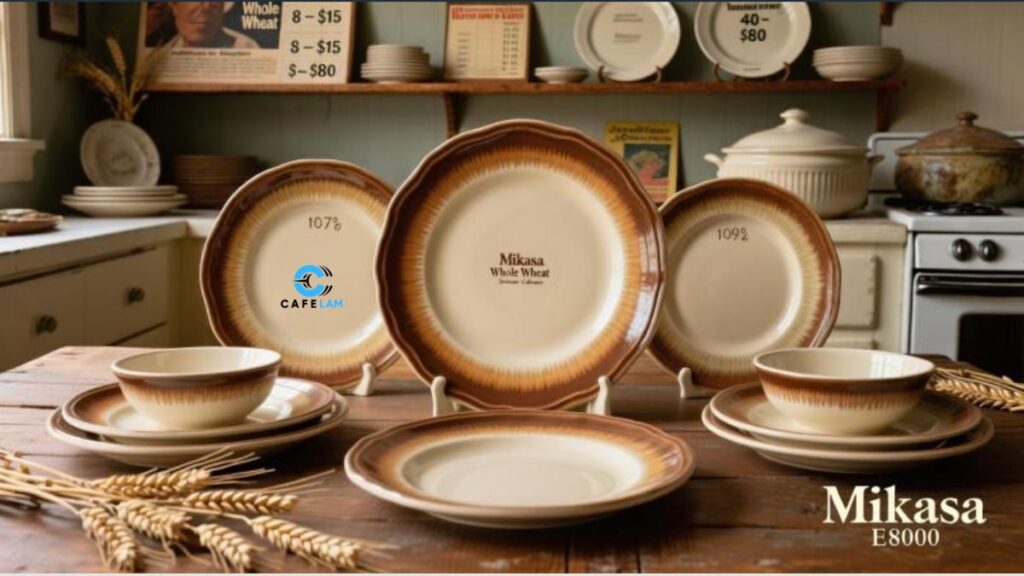Imagine setting your table with dinnerware that perfectly captures the warm, earthy essence of homestyle cooking and rustic charm. Mikasa Whole Wheat stoneware accomplished exactly this during its remarkable 17-year production run, becoming one of the most beloved and recognizable patterns in American households.
This distinctive pattern emerged during the 1970s when natural, earth-toned aesthetics dominated home design trends. With its cream center and rich brown edge that mimicked actual wheat grain, Mikasa Whole Wheat offered families an affordable way to embrace the era’s organic, back-to-nature movement while maintaining everyday functionality.
Today, decades after production ended, Mikasa Whole Wheat continues captivating collectors and home decorators who appreciate its timeless appeal and superior craftsmanship. Understanding this pattern’s history, identifying authentic pieces, and learning proper care techniques can help you build or maintain a collection that brings warmth and character to your dining experiences.
A Journey Through Time: The History of Mikasa Whole Wheat
Mikasa introduced the Whole Wheat pattern in 1976 during a transformative period in American home design. The mid-1970s saw families gravitating toward natural materials, earth tones, and designs that celebrated simplicity over ornate decoration. This cultural shift created perfect conditions for a pattern that embodied rustic elegance and everyday practicality.
The pattern received the manufacturer designation E8000 and quickly established itself as Mikasa’s flagship stoneware collection. Unlike fine china patterns that required careful handling and special occasions, Whole Wheat was designed for daily use, encouraging families to elevate their everyday dining experiences without fear of damage or excessive cost.
Production continued through 1993, spanning nearly two decades and multiple generations of families who grew up eating from these distinctive cream and brown dishes. The extended production period allowed Mikasa to expand the collection beyond basic place settings, eventually offering coordinated serving pieces, accessories, and specialty items that created complete table settings.
During its peak popularity in the 1980s, Mikasa Whole Wheat appeared in countless American homes, wedding registries, and gift-giving occasions. The pattern’s success helped establish Mikasa as a trusted name in affordable, stylish dinnerware that could compete with more expensive alternatives while maintaining superior quality and durability.
Design Features That Define Timeless Appeal
Mikasa Whole Wheat’s enduring popularity stems from several distinctive design elements that work together to create a cohesive, appealing aesthetic.
Color Palette and Finish represent the pattern’s most recognizable features. Each piece showcases a warm cream or ivory center that gradually transitions to a rich chocolate brown edge. This ombré effect mimics natural wheat grain coloring, creating visual interest without overwhelming busy patterns or competing design elements.
Stoneware Construction provides exceptional durability and heat retention that makes these pieces ideal for both serving and cooking applications. The dense, fired clay body resists chipping and cracking while maintaining even heat distribution that keeps food warm longer than traditional ceramic alternatives.
Textural Elements add subtle sophistication through slightly raised edges and gentle surface variations that catch light beautifully. These details create depth and visual interest without sacrificing the pattern’s clean, uncluttered aesthetic that works well with various decorating styles.
Versatile Sizing accommodated different dining needs through carefully proportioned pieces. Dinner plates measured 10¾ inches in diameter, providing ample space for generous portions while fitting comfortably on standard place settings. Coordinated bowls, mugs, and serving pieces maintained consistent proportional relationships that created harmonious table presentations.
Collectibility and Market Value
Mikasa Whole Wheat has developed a strong following among vintage dinnerware collectors who appreciate both its aesthetic appeal and historical significance as a representative piece of 1970s-80s American home design.
Rarity Factors influence collectible value significantly. While millions of pieces were produced during the 17-year run, certain items remain harder to find than others. Specialty serving pieces, large platters, and coordinated accessories typically command higher prices than basic place setting components.
Condition Considerations play crucial roles in determining market value. Pieces showing minimal wear, no chips or cracks, and retention of original brown edge coloring maintain premium pricing. The brown glaze can fade or wear away with heavy use, making well-preserved examples particularly desirable.
Market Trends show steady demand for complete sets and hard-to-find pieces. Online marketplaces, antique shops, and estate sales regularly feature Whole Wheat collections, with pricing varying based on piece rarity, condition, and regional demand patterns.
| Item Type | Typical Price Range | Collectibility Level |
| Individual Dinner Plate | $8-15 | Common |
| Complete 4-Place Setting | $60-120 | Moderate |
| Large Serving Platter | $25-45 | High |
| Soup Tureen with Lid | $40-80 | Very High |
| Coordinated Accessories | $15-35 each | High |
Modern Uses: From Everyday Dining to Special Occasions
Contemporary families discover numerous ways to incorporate Mikasa Whole Wheat into their dining and entertaining routines, proving that good design transcends generational preferences.
Everyday Dining benefits from the pattern’s durability and microwave-safe construction. Modern busy families appreciate dinnerware that can transition seamlessly from microwave to dishwasher without special handling requirements. The warm, neutral colors complement various food presentations while creating inviting table settings for daily meals.
Casual Entertainment becomes more sophisticated when featuring coordinated Whole Wheat serving pieces. The pattern’s natural aesthetic works beautifully for brunches, casual dinner parties, and outdoor entertaining where elegant appearance matters but formal china seems excessive.
Holiday and Special Occasions can incorporate Whole Wheat pieces as charming alternatives to traditional formal dinnerware. The earthy colors coordinate beautifully with autumn decorations, Thanksgiving themes, and rustic holiday presentations that emphasize natural elements over glittery formality.
Mix and Match Styling allows creative decorators to combine Whole Wheat pieces with contemporary dishes, creating eclectic table settings that blend vintage charm with modern functionality. The neutral color palette provides excellent foundation for seasonal accent pieces and colorful additions.
Buying Guide: Finding Authentic Mikasa Whole Wheat
Successfully building a Mikasa Whole Wheat collection requires knowledge of authentication markers, condition assessment techniques, and smart shopping strategies.
Authentication Markers help distinguish genuine Mikasa pieces from similar-looking alternatives. Look for “Mikasa” stamped on the bottom along with pattern names or numbers. Genuine pieces typically display “E8000” or “Whole Wheat” markings, though some earlier pieces may show only manufacturer information.
Quality Assessment involves examining several condition factors before purchasing. Check for chips, cracks, or crazing in the glaze that could affect both appearance and functionality. Inspect the brown edge coloring for fading or wear that diminishes the pattern’s distinctive appearance.
Shopping Locations vary in selection and pricing structures:
- Online marketplaces offer extensive selections but require careful evaluation of seller descriptions and photos
- Antique shops provide hands-on inspection opportunities with knowledgeable staff guidance
- Estate sales may yield complete sets and rare pieces at competitive prices
- Thrift stores occasionally feature individual pieces at bargain prices for patient collectors
Pricing Strategies help maximize value while building your collection. Start with basic place setting pieces before investing in expensive serving items. Consider purchasing incomplete sets that can be supplemented gradually rather than waiting for perfect complete collections that command premium pricing.
Care and Maintenance: Preserving Your Investment
Proper care techniques ensure your Mikasa Whole Wheat collection maintains its beauty and functionality for years of enjoyment.
Daily Cleaning requirements remain simple thanks to the stoneware’s durable construction. Most pieces are dishwasher-safe, though hand washing helps preserve the brown edge coloring longer. Use mild detergents and avoid abrasive cleaners that could scratch the surface or fade the distinctive coloring.
Stain Prevention involves addressing spills and stains promptly to prevent permanent discoloration. The cream-colored centers can show stains more readily than darker surfaces, making immediate cleaning particularly important for maintaining appearance.
Storage Considerations help prevent damage during periods of non-use. Stack plates with protective padding between pieces, store bowls nested carefully to avoid rim contact, and keep serving pieces in locations where they won’t be knocked or dropped during daily kitchen activities.
Damage Repair options remain limited for chipped or cracked pieces, though minor chips can sometimes be smoothed professionally. Prevention through careful handling represents the most effective approach to maintaining collection value and appearance.
Display Ideas showcase your collection while protecting pieces from damage. Open shelving displays work beautifully for decorative pieces, while everyday items should be stored conveniently for regular use without risk of accidents.
Conclusion: Embracing Timeless Style with Mikasa Whole Wheat
Mikasa Whole Wheat represents more than simple dinnerware; it embodies an era when families valued quality, durability, and natural beauty in their everyday possessions. The pattern’s continued popularity demonstrates that good design transcends temporary trends, offering lasting value through both aesthetic appeal and practical functionality.
Whether you’re starting a new collection, completing an inherited set, or simply appreciating vintage American design, Mikasa Whole Wheat provides an accessible entry point into quality stoneware collecting. The reasonable pricing, widespread availability, and proven durability make it an excellent choice for families seeking beautiful, functional dinnerware with historical significance.
Consider beginning your Mikasa Whole Wheat journey with a basic place setting, experiencing firsthand the satisfaction of dining with well-designed, thoughtfully crafted pieces that connect your modern lifestyle with America’s rich tradition of quality home furnishings.
Frequently Asked Questions
Q: Can Mikasa Whole Wheat be used in modern convection ovens?
A: Yes, the stoneware construction handles oven temperatures up to 350°F, though sudden temperature changes should be avoided to prevent cracking.
Q: Are there coordinated glassware or flatware patterns that match Whole Wheat?
A: While Mikasa didn’t produce matching glassware, earth-toned amber or brown glassware complements the pattern beautifully along with wood or bronze flatware.
Q: How can I determine the manufacturing date of my Whole Wheat pieces?
A: Specific dating requires examining maker’s marks and comparing with production records, though most pieces fall between 1976-1993 without precise year identification.
Q: Do reproduction or similar patterns exist that might be confused with authentic Whole Wheat?
A: Several manufacturers produced similar brown-edged stoneware, but authentic pieces always carry Mikasa markings and have distinctive glaze characteristics.
Q: Can individual replacement pieces be found if items break from my set?
A: Yes, replacement services and online marketplaces regularly offer individual pieces, though exact matches may vary slightly due to production variations over time.







